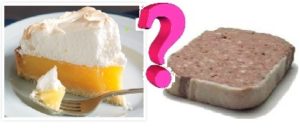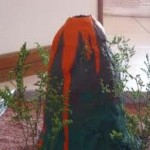What does liver pâté have to do with a lemon meringue pie? Lots actually – well at least word-wise. Say what?
Well it has to do with the Greeks…. who made a mean lemon meringue pie? NO! They did however make good dough or at least a thick pot of barley gruel which they called ‘pastà’ with emphasis on the final a. OK Language Chef, where are you going with all this?
The ancestor of the word ‘pasta’ first appeared in Greece and described a barley dish that the Romans adopted. The Romans began describing any mixture of flour and water, flour and eggs, flour and water and eggs as ‘pasta’ as well. These combos made porridges, doughs and eventually what we’ve come to know as spaghetti, macacroni and tagliatelle. Around the 12th century, the word pasta appears in texts to describe the aforementioned. Also still in modern Italian, the word pasta means both pasta and dough.
The Romans also used the word pasta to describe an adhesive made with ground wheat and water. Ask any 5th grader making a paper-mache volcano as a science project and he’ll tell you that he makes a mixture of flour and water to apply to the strips of newspaper. So the Romans ate glue? Well sort of, and of course, it depended on the cook – some things never change.

As the word moved from Latin into French, the early speakers of French started to lose the ‘s’ and pasta probably started to sound more like ‘paht’ or ‘patay’. And as it described any sort of amalgam of flour and water or eggs similar to Italian, adding sugar or butter to make dough didn’t make a difference. Making a pâte sablée, looked and seemed a lot like making glue or paste so the word ‘pâte’ – pronounced ‘pahT’ was used to describe ‘dough’ or ‘paste’ and still is. However, the word for ‘glue’ in modern French is ‘collant’ refering to its sticking capability, not it’s ingredients.
So why the hat above the â, known as a circumflex? Well sometime during the Middle Ages as French monks were writing this new French language, they started to add the circumflex over letters that in Latin had an S following it, but was no longer pronounced in French. So Pasta or Paste became Pâte or Pâté. 
So liver pâté? Well one must understand how pâté is made. It’s a mixture of meats, offals, wines, cognacs, meal, and seasonings. Making pâté is similar to making dough in that you mix all these ingredients into a sort of ball which looks like dough. And that’s where the relationship exists between pâté and lemon meringue pie. Well not the lemon ot meringue part but the crust part. The word for pastry dough and pâté share a common past.
But comedian, Rita Rudner still wonders…”if you add flour and water, you get glue? Right? But if you add eggs and sugar you get pastry — where did the glue go?”
‘

Robert Aiudi, a.k.a., The Language Chef, has been known to his friends and family as a “language junkie” nearly his entire life. He is fluent in many, conversational in others and can fake it through another large amount of some of the most exotic languages in the world. He has taught and tutored many happy students, and annoyed people over the years by asking “how do you say that?”.
From his young years surrounded by speakers of three different dialects of Italian, to university in France and German and extensive work in Asia, China, Taiwan, Japan, Robert has picked up languages and breathed in the cuisines of many countries. Translating from 27 languages into English, Robert is a repository of anecdotal and factual information about languages of all sorts which adds flavor and depth to the Language Chef.
An expert amateur cook, Robert has worked in Paris in small bistro, made pizzas in Florence, wrangled recipes out of the hands of German grandmothers in the Black Forest, worked in a Chinese restaurant and had ad hoc cooking lessons in restaurants in China, Taiwan and Japan as well as various Chinatowns. Most importantly, Robert, his mom and dad, two grandmothers and lots of aunts from Italy have made culinary magic in their kitchens for generations.








